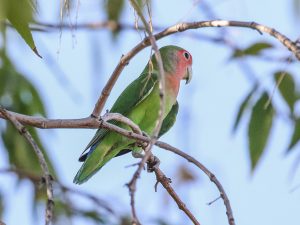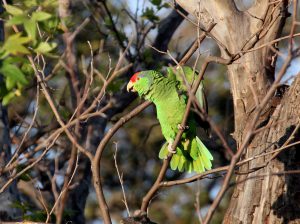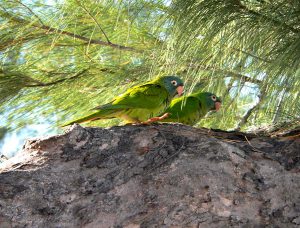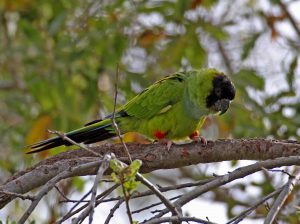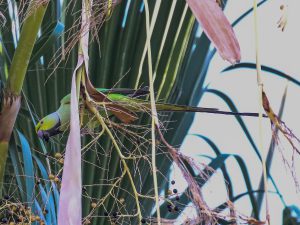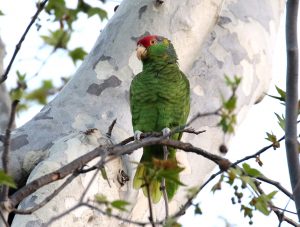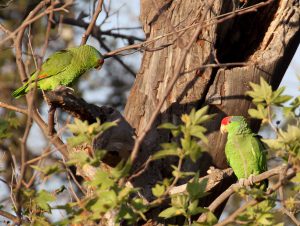Any discussion of introduced bird species in North America would be incomplete without considering exotic parrots. In fact, parrots and their allies constitute the single largest class of exotic birds on the continent. According to Forshaw’s Parrots of the World, there are/were 356 parrot species extant in the world as of 2010. Over 20 psittacids (parrots and their relatives) occur frequently enough in North America that the major field guides illustrate them. Yet only eight species grace the official North American checklist. Of these, arguably only six became established anywhere. Those six are: Monk Parakeet, Nanday Parakeet, Green Parakeet, White-winged Parakeet, Red-crowned Amazon and Rosy-faced Lovebird. See the table of species and their status below.
The irony of it abounds. Historically, North America only ever boasted two native psittacid species: Carolina Parakeet and Thick-billed Parrot. The Carolina Parakeet is famously extinct. Thick-billed Parrot was extirpated from its tiny historical range in the United States decades ago. Moreover, they are endangered in their restricted Mexican range. All efforts to re-introduce Thick-billed Parrots in the southwest met with failure. So any parrot seen in North America is by definition, an exotic. Perhaps many species not on the official checklist are well on the way to becoming established.
Nomenclature of Exotic Parrots
Due in part to the pet trade, names confuse the issue rather than helping. Some species have enough common names that the only way to specify what is under discussion is to resort to cumbersome Latin binomials. Among the many generic psittacid names are: parrot, parakeet, lorikeet, conure, lovebird, macaw, cockatoo, and cockatiel. In fact, even the distinction between parrots and parakeets is completely muddy. For example, Wikipedia begins its Red-masked Parakeet entry with: “The red-masked parakeet is a medium-sized parrot from Ecuador and Peru.” Okay, so which is it?! Other names for this species include Cherry-headed Conure and Red-masked Conure. These birds achieved notoriety from a book about wild parrots living in San Francisco. Similarly, Red-crowned Amazons also go by Red-crowned Parrot, Green-cheeked Amazon, and Mexican Red-headed Parrot.
Typically, parrots are larger stockier birds with proportionally shorter tails. Parakeets are generally more slender and usually have proportionally longer tails. Conure is a term specific to several long-tailed parakeets of the Psittacara genus. Dictionary.com defines “cockatiel” as a “small, crested, long-tailed Australian parrot, Nymphicus hollandicus.” In other words, their definition specifies only one species, and uses cockatiel and parrot interchangeably. But a web search for cockatiel species reveals that Australia has multiple species classed as cockatiels. Lorikeets or lories are “small Australasian parrots with slender tongue papillae forming an organ like a brush.” Hope that helps!
Origins of Exotic Parrots
Unlike many other exotic bird species, the origins of our parrots are relatively unambiguous. Virtually every parrot or parakeet exists here due to the pet trade. The reasons for parrot’s popularity as pets are fairly obvious. These beautiful, highly intelligent, long-lived birds, form deep, lasting bonds with people. As a result, we imported parrot species at such a prodigious rate that some wild populations now face extinction. For example, Red-crowned Amazons are firmly established in California, Florida and probably Texas as well. Their populations here now outnumber the wild birds native to northeastern Mexico, where they are increasingly rare.
Escaped Birds
Many exotic parrots inhabit this country because people released them or they escaped. This probably accounts for the miscellaneous Budgerigars and Gray Cockatiels that I’ve observed in southern California, Arizona and Florida. In some cases, it’s perhaps more tragic. I once saw a full-grown Blue-and-yellow Macaw at a local coastal reserve. The bird posed no threat of becoming established. Folks either recaptured it, or it starved to death or fell prey to a predator. Still, that’s a sad fate for a majestic bird, and probably a grieving owner. Similarly, the Chestnut-fronted Macaw I saw in Chicago’s Grant Park one October probably didn’t persist long in the wild. If you own one of these beautiful and special birds, please take care not to let it escape. Simply nothing good comes of that. Other Chestnut-fronted Macaws seem to do better, like the ones living wild in southeastern Florida.
Conflicts With Native Birds
When exotic parrots thrive, probably their largest impact upon native birds is competition for nest cavities. Many parrots are obligate users of cavities, putting them directly into conflict with native birds. Furthermore, no parrots don’t usually use artificial nest boxes. The fact that zoos get parrots to breed in nest boxes suggests that this might be possible though. Still, the fact remains that competition from exotic parrots represents a new problem for our already beleaguered native birds.
Most exotic parrots live in the southern parts of North America like Florida, Texas, Arizona and southern California. The Monk Parakeet provides an exception to this, due to a quirk in their biology. Monk Parakeets are native to the Andean foothills of South America. Hence, they adapt well to colder temperatures. Monk Parakeets are unique in that they roost and breed colonially in massive stick nests, essentially big parakeet condominiums. This creates shared body warmth which helps them deal with colder temperatures. And that allowed them to colonize climate zones not usually accessible to other psittacids. Thus, we find colonies of Monk Parakeets in no less than 15 states! When sub-zero temperatures beset them at a Chicago colony, they abandoned the nest and roosted over the heating vents of nearby apartments, basking in the warm air. Pretty smart!
Other Impacts
Impacts fall into several classes. First are the impacts our pet trade has on wild psittacid populations. In some cases, captures for the pet trade have decimated wild populations. For example, Red-masked Parakeet constitutes the 10th most commonly imported psittacid. Native to southwest Ecuador and northwest Peru, the decline of wild populations led the IUCN to reclassify it from “least concern” to “near threatened”. Part of this may also be due to habitat loss in their native range, but the point remains.
Another impact of exotic parrots concerns food. Most parrots like fruits and nuts, meaning they become problematic when they proliferate agricultural regions. Many states class Monk Parakeet as an agricultural pest because it easily colonizes new areas. Thus, it cannot legally be imported into, sold or owned in California, Georgia, Kansas, Kentucky, Hawaii, New Jersey, Pennsylvania, Tennessee, Wyoming or Western Australia. Self-sustaining Monk Parakeet populations now exist in 28 nations and assorted islands.
A less-often cited impact of exotic psittacids is that the rapid rate of change in their status makes it virtually impossible for field guides to keep up with them. Many of them, particularly the Amazons, look and sound much alike. This just compounds the problem for people who wish to monitor them. It’s a vicious cycle. If you cannot distinguish them, you cannot census them. And in the absence of solid population data, how do you determine range maps for field guides? Most field guides solved this problem by omitting range maps for these birds. That further complicates the problem by making it hard to know what parrot species to expect in any given area. It gets worse. When small populations of birds have difficulty locating each other, they interbreed with near relatives. That results in unrecognizable hybrids.
Conclusions
So what may we infer from all this? First, note that introduction of exotic animal species may cause untold damage to the environment and economies. This generalization extends well beyond just exotic parrots and their allies. But it holds particularly true for parrots. Their intelligence, cooperative social behaviors and adaptability make them formidable potential pests. Their capacity for long life only exacerbates this.
This is not to say you should never own a parrot. But if considering purchasing a bird, think carefully. Many parrots live a long time, larger ones often exceeding 20 years of age. So right away, buying one constitutes a long-term commitment with incumbent responsibility for the owner. Due to their high intelligence, parrots require a stimulating home environment. These birds easily become depressed and unpleasant if they lack sufficient company or stimulation. And unless you keep multiple birds, their welfare requires much of your companionship. Do not ever deliberately release a parrot or parakeet into the wild. Do not ever let your parrot out “for exercise” even in your own yard. Except for pinioned birds incapable of free flight or tethered securely, escape remains a constant threat. Remember also that parrots have beaks like can openers and they are quite capable of severing less sturdy tethers.
For birders living in states with feral or established parrot populations, it pays to learn how to identify them. Only accurate population assessments yield the data required for informed decisions about what to do about them. Here in southern California, we see huge wild flocks of mixed parrots and parakeets, some well over 500 birds. And their numbers are stable or increasing. In any case, once they’re here, they’re here to stay. We recommend trying to enjoy them!
Table 1: List of Common Exotic Parrot Species in North America
| Brotogeris Parakeets | Binomial | Status |
| White-winged Parakeet | Brotogeris versicolurus | small feral CA populations, established FL |
| Yellow-chevroned Parakeet | Brotogeris chiriri | small feral southern CA and FL populations |
| Psittacara Parakeets | ||
| Blue-crowned Parakeet | Psittacara acuticaudatus | small feral FL and CA populations |
| Mitred Parrot | Psittacara mitratus | small feral FL, CA and NY populations |
| Red-masked Parakeet | Psittacara erythrogenys | small feral FL and CA populations |
| Green Parakeet | Psittacara holochlorus | large established TX population, casual FL |
| Black-hooded Parakeet | Psittacara nenday | large increasing FL and southern CA populations |
| Dusky-headed Parakeet | Psittacara weddellii | small feral population in Florida |
| White-eyed Parakeet | Psittacara leucophthalmus | small feral FL and CA populations |
| Amazona Parrots | ||
| Orange-winged Parrot | Amazona amazonica | casual escapee Sunbelt cities, small FL population |
| Blue-fronted Parrot | Amazona aestiva | casual escapee Sunbelt cities |
| Mealy Parrot | Amazona guatemalae | casual escapee Sunbelt cities |
| Red-lored Parrot | Amazona autumnalis | casual escapee Sunbelt cities |
| White-fronted Parrot | Amazona albifrons | casual escapee Sunbelt cities |
| Red-crowned Parrot | Amazona viridigenalis | established FL, TX and CA populations |
| Lilac-crowned Parrot | Amazona finschi | increasing feral southern CA population |
| Yellow-headed Parrot | Amazona oratrix | casual escapee Sunbelt cities |
| Yellow-naped Parrot | Amazona auropalliata | rare escapee Sunbelt cities |
| Yellow-crowned Parrot | Amazona ochrocephala | rare escapee Sunbelt cities |
| Cockatoos | ||
| Sulphur-crested Cockatoo | Cacatua galerita | occasional escapee |
| Macaws | ||
| Blue-and yellow Macaw | Ara ararauna | occasional escapee |
| Chestnut-fronted Macaw | Ara severus | small feral FL population |
| Miscellaneous Psittacids | ||
| Budgerigar | Melopsittacus undulatus | occasional escapee, small declining FL population |
| Monk Parakeet | Myiopsitta monachus | widespread small established populations |
| Rose-ringed Parakeet | Psittacula krameri | small populations in southern CA and FL |
| Gray Cockatiel | Nymphicus hollandicus | casual escapee Sunbelt cities |
| Rosy-faced Lovebird | Agapornis roseicollis | small population established in AZ |

